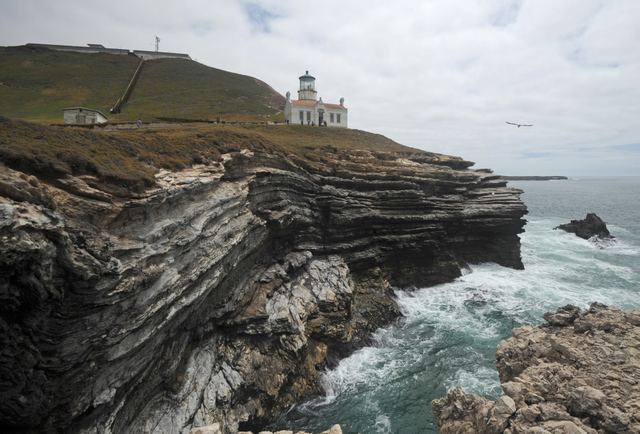Preserving Point Conception’s Lens
Expert Lampists Moving Lighthouse Pieces to S.B. Maritime Museum

On Monday morning, as bright sunshine cut through puffy clouds and ever-steady winds whipped the western edge of the continent, three of the nation’s five certified lampists could be found atop the Point Conception Lighthouse, carefully removing the historic landmark’s precious lens.
Built in Paris, shipped around Cape Horn, and installed in 1855, the 12-foot-tall, six-foot-wide lens is really an array of dozens of individual prisms — each reportedly costing more than $100,000 to replace — that once shined a beam of light more than 20 miles out to sea, though one captain in 1856 claimed to see a flash from more than 42 miles away. As the centerpiece of Point Conception Lighthouse, one of California’s first lighthouses, the lens kept most ships away from the state’s rocky southwestern corner until it was decommissioned and updated with a newer light in 1973. Based on designs first invented by French physicist Augustin-Jean Fresnel in 1821 — whose basic focusing technology persists in the modern light, albeit in much smaller and acrylic form — the lens is being moved over the next few weeks to the Santa Barbara Maritime Museum, where it will survive as part of an exhibit that opens in September.
“Fresnel had the right idea,” said lead lampist James “Woody” Woodward, who spent 40 years working on lighthouses out of the U.S. Coast Guard’s office in Cleveland, Ohio, before moving to Arizona and continuing to consult as one of the country’s few Fresnel lens experts. “He knew what he was doing, and no one has improved on that.”
Financed by the museum’s ongoing $500,000 fundraising campaign, the preservation project is underway now because the Coast Guard is currently transferring the small chunk of land where the lighthouse sits to Vandenberg Air Force Base. “It’s excess property,” said the Coast Guard’s Michael Badar, who is based in Long Beach, where other parts of the lighthouse, such as the antique cabinet, will also find a permanent place as public exhibits. The Coast Guard will continue to protect the national landmark and maintain the modern light, which is not used much by commercial ships anymore but serves a purpose for recreational boaters and fishermen who don’t have GPS and radar devices.
But because of that transfer — as well as the existing hurdles required to pass through the private Cojo Ranch that surrounds the property — the lighthouse will essentially be completely off-limits to the general public. So the Maritime Museum proposed taking over the lens as part of an exhibit to keep its history alive and accessible, including a chance for the public to see the preservation work in action this summer before it opens on September 21.
Along for the tour on Monday was Bruce Drugg, who lived at the point with his wife for “two years and one day” from 1969 to 1971, as did his son, Mark, from three days to nine months old. As Bruce teared up while talking about his memories, Mark experienced the mystical setting for the first time since a baby a bit in awe, explaining, “It’s part of our family mythology.”
Others just marveled at the rare and possibly last chance to experience this legendary corner of California, revered by the Chumash people as “Humquq,” the place where souls began their journey to the afterlife, and named after the Feast of the Immaculate Conception by Spanish explorer Sebastián Vizcaíno in 1602. Since then, Point Conception has been mostly known for shipwrecks, surfing, and science, as it’s the place where the cold waters of Northern California collide with the warmer waters of the south, making for interesting biological diversity. During its heyday, though, the Point Conception Lighthouse complex housed four families in various structures, said the museum’s Emily Falke, who explained, “This was like a village at the time.”
Lampists like Woodward do lament the slow decline of lighthouses nationwide, but the real problem started way back in 1939, when the federal government folded the U.S. Lighthouse Service into the Coast Guard, and the existing apprenticeship system collapsed. “Unfortunately, the majority of the lighthouse personnel vaporized,” explained Woodward, who just happened to learn the trade from one of the service’s last remaining lampists, Arthur Mienhold. “I learned in the old-fashioned way from the master.”
Though Woodward said that his work is sporadic, with no lighthouse jobs in 2012 but an “overloaded schedule” this year, he is on the lookout for some young folks interested in learning the trade. He is on the verge of retirement, as is another colleague, which would leave just three certified lampists in the country. Woodward believes Fresnel would be pretty proud that his lens design lasted nearly 200 years, and he does not decry the ongoing rise of LED technology in lighthouses, which will one day reach Point Conception as well. “I don’t see it as a threat,” said Woodward on Monday, the Pacific’s mighty waves crashing into the jagged cliffs over his shoulder. “I see it as progress.”



